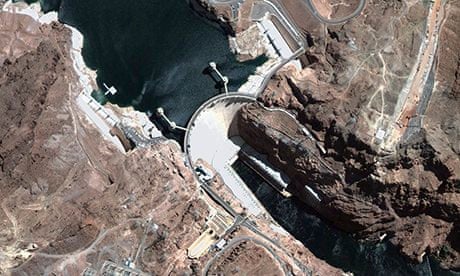Concerns are intensifying in the US about the troubling interdependence of the economy's water and energy needs. In particular, the vast quantities of water (about 40% of national water withdrawals) needed for cooling US power plants are making headlines, and proposals to build thirsty new generation plants in drought-stricken states like Texas are under heavy scrutiny. Hydropower is also under strain from climate change, as more and more "one in a hundred years" droughts are reducing rivers to a trickle and power generation to a near standstill.
But in the EU, this growing collision between energy and water resources has been strikingly absent from public discussion, let alone from the EU energy agenda.
That's not to say scientists aren't trying to put it there. I recently had the pleasure of seeing John Matthews, director of freshwater and climate change at Conservation International, wake up an otherwise sleepy crowd of Commission staff and MEPs in Brussels with this powerful image of Las Vegas' dwindling Lake Mead and America's most iconic – and soon to be stranded – hydro-power asset, the Hoover Dam. The southwest US is painfully close to losing an important energy source for 1.3 million people living in Arizona, Nevada and California.
Which is why utilities in this region are scrambling to cut water use. Arizona Public Service (APS), for example, is using treated wastewater for 62% of its cooling water. California-based PG&E is partnering with local water utilities to combine customer rebates for purchases of water-efficient household appliances. In 2012, PG&E's program was estimated to save more than 1.3bn gallons of water and 12m kilowatt hours of electricity.
Still, I wasn't sure if European legislators and investors in Brussels would relate to these challenges 5,000 miles away. Judging from the chorus of gasps to Matthew's slides, the point was driven home.
And it's not just scientists and NGOs prodding the regulators on these trends. European utilities such as Enel are also voicing concern. Enel is a multinational heavyweight in the power sector, with generation and distribution activities in 40 countries. Of the company's 98GW of installed capacity, a whopping 31% comes from hydropower. The company is also under strict carbon emissions targets in the EU, and a stable, low-carbon hydropower portfolio is critical to meeting them. For Enel, the water-energy collision is much more than an interesting catchphrase.
"Water is core to our business – we need to protect it to deliver power, meet our business goals, as well as keep our carbon footprint down," Andrea Valcalda, Enel's head of environment, told a recent forum of EU lawmakers.
That's one reason Enel is joining APS and other US utilities in shoring up its water risk management strategy using the Aqua Gauge a tool Ceres and WBCSD developed to help companies improve their performance and better navigate water issues in an age of climate change.
One important action area the Aqua Gauge identified for Enel relates to the water impacts of the company's fossil fuel supply chain – specifically, coal and natural gas. Marianne Wenning, director for water issues at the European Commission, has been particularly vocal about the uncertainties of potential shale gas production on Europe's water resources. (Again, Texas provides potential lessons: hydraulic fracturing of shale oil and gas is booming and in many parts of the state is using massive amounts of water from wells and underground aquifers.) As estimates of new shale energy reserves increase every day in France, the UK, and Poland, she and other EU policymakers would do well to improve upon the wild-west fracking experiments in the US.
And it looks like indeed they might. Just last month European lawmakers approved legislation that would require energy companies to carry out rigorous environmental audits before using hydraulic fracturing technologies.
Surely though, this is in some ways just the opening salvo of a broader debate on the water-energy collision in Europe. Let's all take note, and begin managing and investing towards a future that protects our water resources, our climate, and our energy security.
Brooke Barton is director of water programs at Ceres, a nonprofit organization working to mobilise business and investor leadership on sustainability. Follow her on Twitter at @brookedbarton
Join the community of sustainability professionals and experts. Become a GSB member to get more stories like this direct to your inbox

Comments (…)
Sign in or create your Guardian account to join the discussion